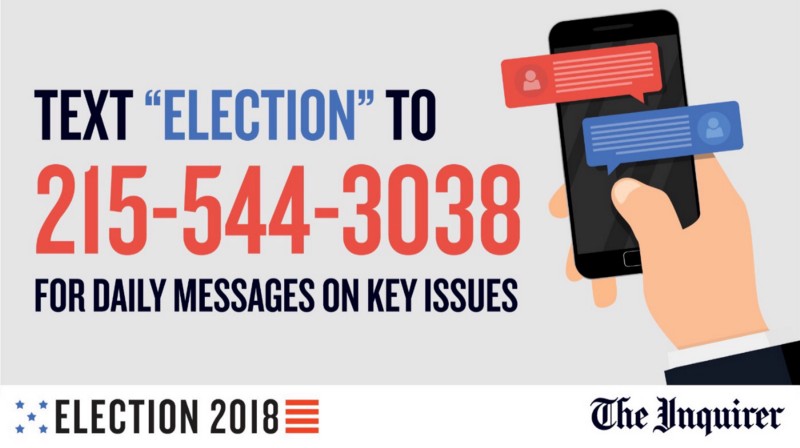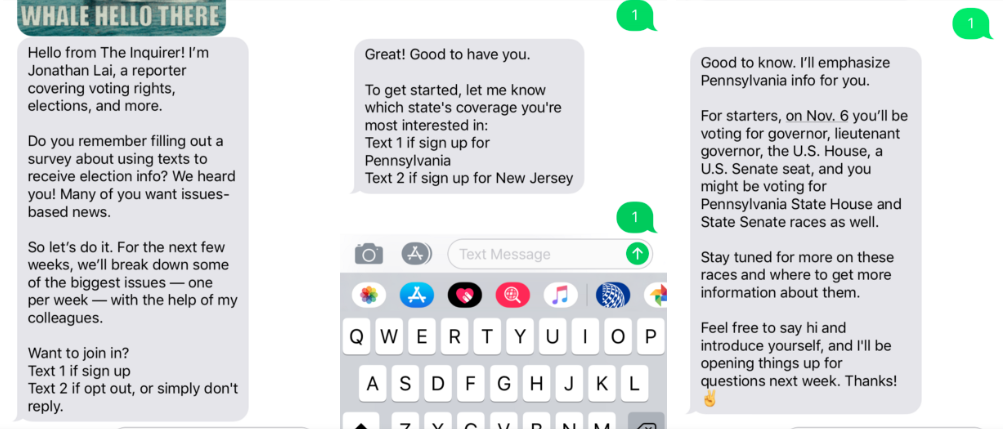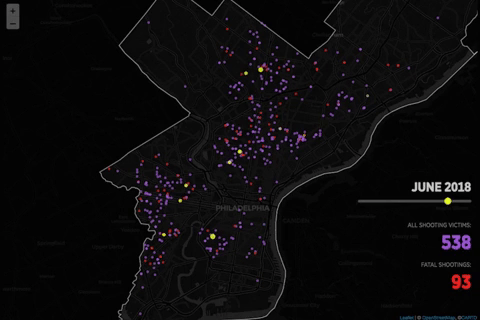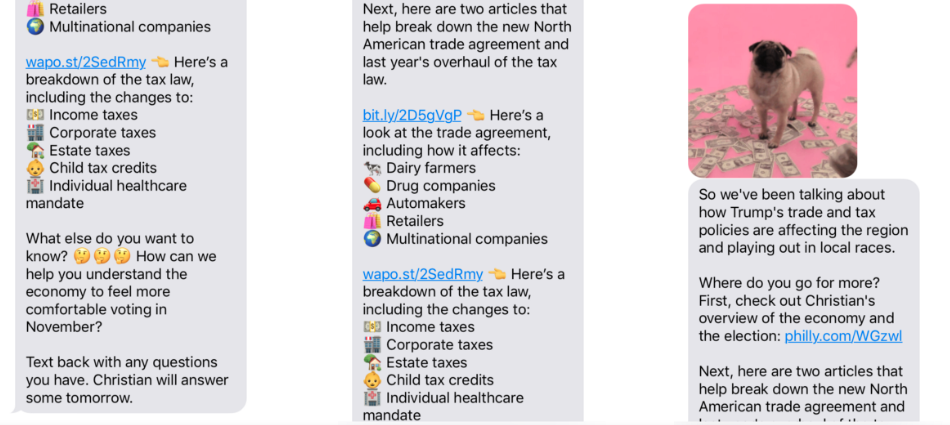
Text messaging gets overlooked in most local news strategies. Maybe it seems too simplistic. Maybe it feels too personal or intimate. Or maybe it just doesn’t seem like journalism. (Spoiler: It is.)
But the list of reasons for newsrooms to consider adding texts to their mix of products is growing. Here are just some of the top reasons to consider trying it yourself.
— Nearly 2 trillion messages were exchanged in 2017.— Texting is more accessible to many audiences than news sites and apps, which depend on expensive data plans and internet connections to use.
— Text message “open rates” are much higher than email, and annoying spam is much less common.
— There are now several low-cost platforms that make texting at scale easy, including the one we used for this project, GroundSource, built by veteran journalist Andrew Haeg.
Plus, it works. We were inspired by the positive results of texting experiments at KPCC Southern California Public Radio, Outlier Media in Detroit, and City Bureau in Chicago. We at the Lenfest Local Lab wanted to see what we could do here in Philadelphia.
So given the popularity, accessibility, and affordability of texting, we decided to experiment with it for the November 2018 midterm elections to see whether — as Philadelphia Inquirer managing editor of audience and innovation Kim Fox likes to say — there was any “there there.” There was.
A journalist. This texting experiment began with an email from Inquirer reporter Jonathan Lai to his editor that included a smart list of new midterm election coverage ideas. Here’s what he wrote about texting:
The premise is that people are busy and voting can be complicated. With politics moving so quickly these days (and a new congressional map!), a service to proactively help people vote could put our work in front of people in a new way and also build an identity as a place to go for this kind of information.
Exactly. These days, people are busy, elections are complicated, and news moves quickly. Journalists seek new ways to become the go-to information source for voters, and texting seemed like a good fit to Jonathan. Texting also seemed like a way to allow people to pare the constant stream of news down to just what mattered to them the most. It also gives people the opportunity to reach out directly to a journalist if they want to know more, or if any of their questions weren’t answered in an article.
It took a few weeks to build a plan around Jonathan’s idea and launch the experiment; you can read more here about the research and collaboration process we used to get there. Here, we’ll share everything that happened once we launched the experiment — including how we promoted it, what the texts looked like, how they performed, and what we learned.
The text messages ran for just over three weeks; Jonathan usually sent one a day. Each week, the messages broke down a single issue at stake in the midterm election. He also highlighted some key races and gave people ways to dive deeper on the issues on the Inquirer’s website, other news sites, and public information sites.
We used the GroundSource platform to send the messages; people could sign up by texting the word “ELECTION” to 215-544-3038 or by entering their phone number into a GroundSource widget that appeared in the article promoting the service.
We promoted the experiment primarily through Jonathan’s Philly.com article introducing the experiment. He let people know how they could sign up and what to expect. The Inquirer, our lab, and various reporters and editors shared the link through social media, and the Inquirer included the link in its morning newsletter.
The experiment was also promoted on one side of the postcard below, which was handed out at an Inquirer booth at the Pennsylvania Conference for Women October 12.

Illustration by Jared Whalen.
People who signed up received a welcome message from Jonathan. He introduced himself, explained again what the texts would include, and offered a choice between Pennsylvania or New Jersey election news since the Inquirer covers politics in both states.

Steps 1, 2, and 3 of the welcome process, preceded by a welcoming whale gif.
In the last step of the welcome process, we wanted to provide some extra value, since we had people’s attention. We decided to include a few important state-specific reminders well in advance of Election Day — including the election date and what offices were up for grabs in their state. We similarly customized the day-before and day-of voting information for Pennsylvania and New Jersey voters on November 6 since some details (such as voting hours) differed between states.
Jonathan “hosted” the texts with Inquirer colleagues who helped him break down the issues each week. The texts were mostly adapted from Inquirer articles about three key issues: health care, gun control, and the economy.
An additional article was written each week by one of Jonathan’s colleagues, answering questions received from people throughout the week. Here are those articles:
We had fun thinking of phone-friendly visuals to add to the texts.

Inquirer reporters Jonathan Lai and Christian Hetrick introduce themselves.
Here’s a gif of Inquirer economic policy reporter Christian Hetrick drafting responses to audience questions.

We were also able to add in a mix of other images, including a map of gun violence incidents in Philadelphia.

Map by Garland Potts and Jared Whalen.
Here’s a summary of how the texts performed in terms of audience size and engagement, the value people received from the texts, and how they were directly monetized. (The full analysis, completed by our partners at Hero Digital, is also available here for anyone who wants to take a deeper dive into the metrics.)
We sent out a survey after the experiment was over and received a range of feedback from people on the experience. Here’s a representative sampling:
Positive:
This was a great service. You earned my subscription. I have enjoyed the coverage, and I subscribed to online plus Sunday. All the best and thank for all your work to help voters.
I thought you did an amazing job and you covered everything I was concerned about with the candidates. Also as an added bonus I felt like you were actually there and I could just talk to you if I needed to. It was one of the best things I ever signed up for!!!
It was great to receive informative texts and were very easy to navigate for what I wanted to know.
Negative:
It felt like information overload, because I also read the daily Philly.com emails and generally live my life on Twitter. But maybe that just means I wasn’t the ideal recipient of this campaign.
Reading the information on the phone was too tedious. It’s very hard to read. I would prefer email.
I wish you would have had more information than what I already saw on different news sites. Employment is my number 1 concern.
Our plan was to adapt the text messages from articles the Inquirer had written about key election issues. While there are some similarities between writing news copy and writing text messages, we learned some important differences — driven mostly by format constraints.
The first constraint is length. It’s unusual for a text message to be longer than the phone screen itself — which is a challenge when you’re trying to summarize, say, two candidates’ positions on a key issue. Many texting apps indent messages so you can parse what you send from what you receive, which further reduces the space you have to stay on one screen. Setting character count limits for yourself at the beginning and sticking to them can help you make best use of the platform.
The second constraint is scannability — especially if your text message is on the longer side. Thinking about ways to make data points and other details easy to read and scan on a small screen is important, and sometimes we used emoji to group pieces of information together in a small space.

The third constraint is making sure the content you’re adapting (if you have it) supports the features you offer. We offered a level of personalization in the text messages that wasn’t supported by the articles we were trying to adapt. We let people select Pennsylvania or New Jersey election news, and sometimes that meant we had to ask our colleagues to do additional reporting (or do original reporting ourselves) to support that level of personalization.
Speaking of personalization, if you allow people to sign up for one thing or another — in our case, Pennsylvania or New Jersey news — consider also letting them sign up for both if you can support it. (FOMO is real, even with politics news.) Just because someone lives in New Jersey doesn’t mean they’re not interested in Pennsylvania political news, and vice versa. If we were to do this again, we might offer a third option — but given the timing and the size of our team, we stuck to just two.
First and foremost, we learned that a running dialogue between one reporter and a few hundred people about political news is doable. Even though drafting, editing, and approving the texts — not to mention keeping up with responses — sometimes took up a good part of the day for Jonathan, the lab, and his colleagues, the hope is that in a future project there would be more pre-work done, less signoff needed, and more familiarity with the platform, all of which would reduce the number of hours needed to spend on the texts.
Two things made it possible to handle that dialogue with people: the platform (GroundSource) and the reasonable number of responses. We received around 10 or 12 questions or responses per week, and Jonathan, myself, and our editorial director André Natta were usually able to respond right away or within about a day. People’s responses were, for the most part, genuine, respectful, and even friendly. Here are just a few:
I voted this morning at 7:20 and was already the 50th voter. No problems! Thank you for all your hard work and the great info you provided. You did a great job and it was a terrific service!!
Thank you very much for these updates and discussions! I’ve made use of the information. I voted at 8:30 this morning at Archbishop Ryan and was third in line. No issues and was very proud to wear my “I voted” sticker! :) Thanks again!
Voted before 7:00 this morning and was #13 in A-K line which is a higher # than I am normally!
The results helped ease some of our fears that the responses would become overwhelming, and the GroundSource platform also made it relatively easy to see a text come in and type the response directly into the tool.
There’s no getting around it — this took time to pull off. Despite our pre-planning, access to GroundSource, and a dedicated three-person team (Jonathan, André, and me), the process often took hours (sometimes nearly a full day) to complete. The time to draft the texts, edit them, debate ad-hoc strategies around things like the use of emoji, coordinate with other reporters, and also get approvals from desk editors and managing editors added up.
Some days, the time flew by because we had lots of new ideas. Sometimes the workflow dragged, because we paused for approvals or tried to fit regular workday tasks in between the texting workflow. But we’re confident that with more use of the tool, more experience editing for text messages, and more familiarity with the format, we could greatly reduce the amount of time it took each day to send texts.
You could further reduce the time it takes to send texts by reusing existing content, like push notifications, which wouldn’t require a lot of editorial reimagination in order to send. However, we found overall that texting, just like any new format — like newsletters or social media — still requires focus to get it right.
If you’re thinking of running a similar project in your newsroom and want to reduce the time it takes, you might consider a few things:
It’s common for product development teams to have a meeting after an experiment to reflect on how things went. Sometimes they’re called a retrospective or a post-mortem. In the Lenfest Local Lab, we call them burndowns, and we talk about three things: 1) What went well? 2) What didn’t? 3) What could we do better next time?
If you want to give texting a try, here are some things we said we would do better next time; hopefully, they can give you and your team a head start.
A version of this piece appeared on Medium. The Lenfest Local Lab, a small, multidisciplinary product and user experience innovation team located in Philadelphia, is supported by the Lenfest Institute for Journalism and led by the author, Sarah Schmalbach.